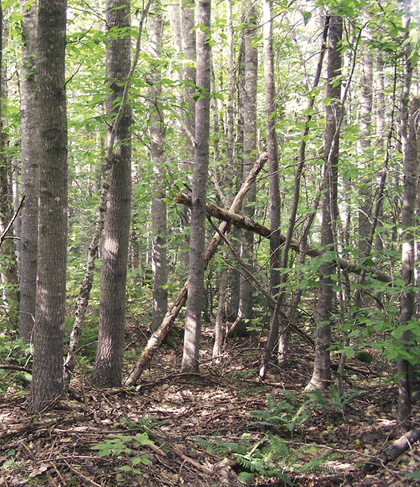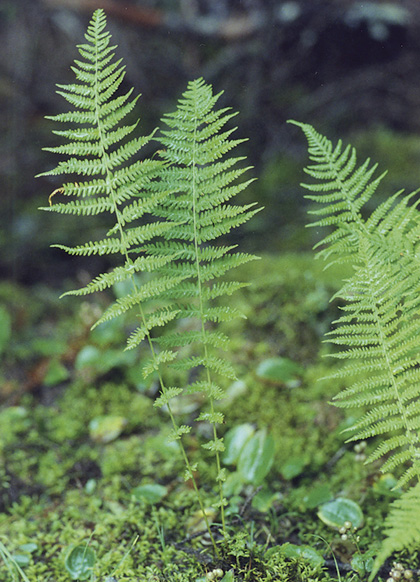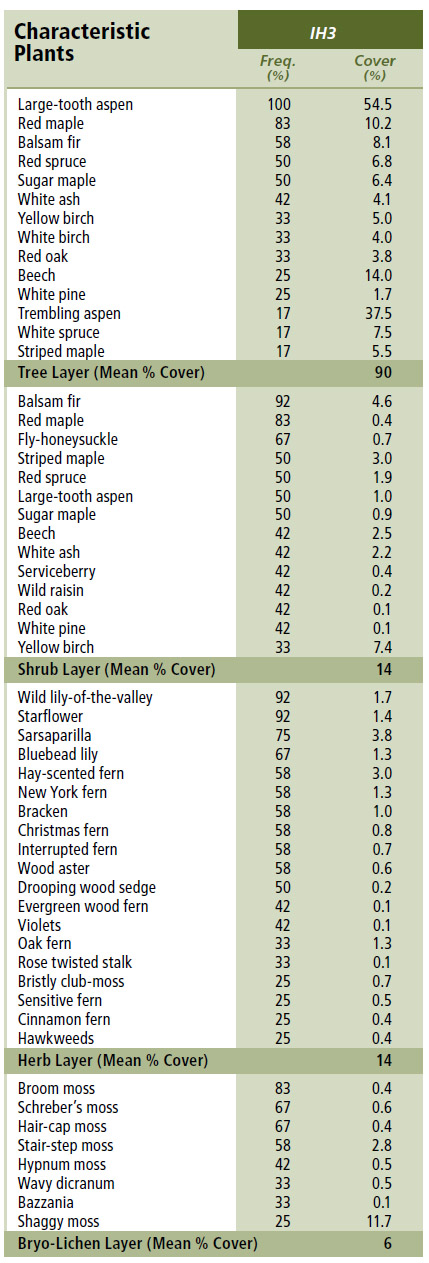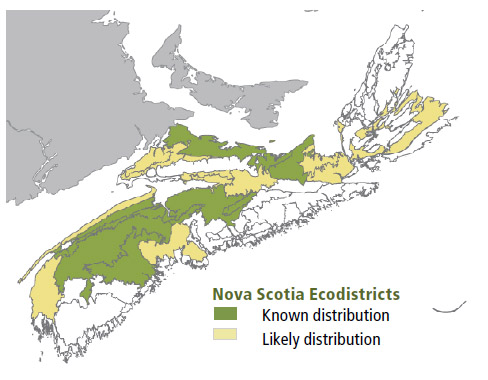
Forest Vegetation types - IH3
IH3 — Large-tooth aspen / Christmas fern – New York fern
Populus grandidentata / Polystichum acrostichoides – Thelypteris noveboracensis
 |
Lily Lake, Annapolis County |
Concept: This early successional Vegetation Type (VT) has an overstory dominated by large-tooth aspen and a variable mix of shade-tolerant hardwood species, balsam fir and red spruce. It is similar to IH1 (Large-tooth aspen / Lambkill / Bracken) but it is found on richer sites, as evidenced by a change in herbaceous cover and tree species composition. Large-tooth aspen / Christmas fern – New York fern usually follows stand-replacing disturbance events such as fire, windthrow or clearcutting. Most large-tooth aspen originates as vegetative regeneration from root suckers.
Vegetation: Red oak, red maple and white birch are the dominant overstory trees, along with occasional large-tooth aspen, black spruce and balsam fir. The overstory may also include a few scattered white pine in a super canopy position. These relict trees are usually survivors of past disturbance events. The shrub layer is well developed, often including wild raisin, serviceberry, velvet-leaf blueberry, witch-hazel and/or lambkill, along with regenerating trees (especially red oak, red maple, balsam fir and white pine). In the herb layer species indicative of poor, dry conditions include bracken, teaberry, round-leaved pyrola, mayflower, pink lady's slipper and/or princes'-pine. The bryophyte layer is poorly developed.
Environmental Setting: IH3 is an early successional VT that follows stand-level disturbances in both softwood and hardwood forests. Typical disturbance agents include fire, windthrow and harvesting. IH3 stands are usually dominated by even-aged, clonal-origin large-tooth aspen. Short-lived aspen will deteriorate due to natural senescence, with mortality further accelerated by insect predation, disease and/or wind damage. A mix of shade-tolerant softwoods and hardwoods in the shrub layer allows for a range of possible successional VTs including IH7 (Red maple / Hay-scented fern – Wood sorrel), MW1 (Red spruce – Yellow birch / Evergreen wood fern), MW3 (Hemlock – Yellow birch / Evergreen wood fern), SH3 (Red spruce – Hemlock / Wild lily-of-the-valley), TH1 (Sugar maple / Hay-scented fern), TH2 (Sugar maple / New York fern – Northern beech fern), TH3 (Sugar maple – White ash / Christmas fern), and in western Nova Scotia TH6 (Red oak – Yellow birch / Striped maple).
Successional Dynamics: Relatively dry, nutrient poor soils associated with this VT may lead to an edaphic climax community dominated by red oak, white pine and black spruce. Historically, stand maintaining fires would have reduced understory fuel loads and promoted red oak and possibly white pine presence until the overstory was destroyed by intense canopy fire. (Although the role of low intensity fires in red oak development is not well understood, it appears to be an important component of successional history in some stands.) IH2 can develop from IH1 (Large-tooth aspen / Lambkill / Bracken) stands and, once established, can maintain itself or transition to SP9 (Red oak – White pine / Teaberry). As the potential impacts of fire are reduced through management, IH2 could succeed to SP4 (White pine / Blueberry / Bracken) or on –White pine / Lambkill / Bracken).
Ecological Features: This early successional small patch forest is short lived. Large-tooth aspen is a very shade-intolerant tree and its regeneration is primarily through clonal reproduction from root suckers (which may support large fungal associates such as shoe-string root rot). Aspen colonizes sites rapidly after stand-level disturbances acting as a “nurse crop” for later successional species that tend to grow up through the aspen, forming two-layered stands before the aspen is overtaken and dies out. Regenerating aspen stands provide cover and forage for many species. Moose and deer feed on its leaves and twigs, ruffed grouse eat its winter buds, snowshoe hare and mice consume its bark and twigs, and beavers make its bark a dietary staple. Resin from aspen buds is the primary source of bee propolis, an essential hive material. Older aspen trees provide soft snags and cavities for several species of birds. Aspen support many insects, most notably the forest tent caterpillar, which is an important food for birds and small mammals.
 |
| New York fern (John Gillis) |
Distinguishing Features: This hardwood forest occurs on well to imperfectly drained, nutrient rich soils and is dominated by large-tooth aspen. Moist site indicators include interrupted fern, cinnamon fern, sensitive fern, bladder sedge, other sedge species and buttercups. Rich site indicators are Christmas fern, lady fern and large
leaf aster.
| Slope Position: | Level4 Lower2 Middle2 Upper2 |
Surface Stoniness: |
(Non - Slightly)6 (Moderately)1 (Very - Excessively)1 nd2 |
Bedrock Outcrop: |
(Non-rocky)8 nd2 |
Elevation Range: |
33 - 190m |
Slope Gradient: |
Gentle6 Level3 Moderate1 |
Aspect: |
North3 East2 South3 None2 |
Exposure: |
Moderate6 Mod. exposed2 nd2 |
Microtopography: |
Slightly4 Moderately2 Strongly2 nd2 |
Drainage: |
Moderately well5 Imperfect2 Poor1 nd2 |
Soil Type: |
ST123 ST82 ST112 ST91 ST2-L1 nd1 |
Parent Material: |
Glacial till10 |
Rooting Depth (cm): |
(30-45)3 (>45)5 nd2 |
Duff Thickness (cm): |
(0-5)5 (6-10)3 nd2 |

